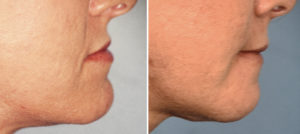Background: The sliding genioplasty is a well known chin procedure that has both a long history and a variety of uses. In its classic form it is a horizontal chin advancement procedure by a forward repositioning of the mandibular symphysis bone. With the advent of plate and screw fixation, the procedure has been expanded to vertical lengthening as well as widening and narrowing changes.
The one dimensional change for a chin osteotomy that is rarely talked about is a primary reverse sliding genioplasty. This is when the procedure is done to reduce a protruding chin, not when an initial sliding genioplasty is secondarily reversed. While it would seem to be a logical choice for horizontal chin reduction, it is not. Very much like chin implant augmentation it works and makes the chin look better because it stretches out the overlying soft tissues. But when taking a chin implant what happens to the soft tissues….a relative excess occurs in many cases.
In a primary reverse sliding genioplasty the problem is not so much the overlying soft tissue pad but the neck tissues beneath it. As the chin bone is slide back it releases the tension in the genioglossus and geniohyoid muscles. This causes them to sag and push down creating a submental fullness effect. This may be enhanced by the sides of the chin bone creating a reverse step off along the inferior border.
Case Study: This young female was undergoing a LeFort 1 advancement and requested a chin reduction at the same time. She wanted a reverse sliding genioplasty as she did not want a submental incision for the chin reduction.

I learned decades ago (as evidenced by these old pictures) the a reverse sliding genioplasty was not a good chin reduction procedure. Like all chin reduction procedures you have to account for the soft tissue excess and redistributing it to another regional location is usually not a good aesthetic choice.
Highlights:
1) A sliding genioplasty moving forward is a good procedure because it stretchs the neck tissue out.
2) A reverse sliding genioplasty as a primary procedure for chin reduction is not a good procedure because it creates submental fullness.
3) The submental fullness is created by a soft tissue redundancy from the bunching of neck tissues and the creation of a soft tissue ‘excess’.
Dr. Barry Eppley
Indianapolis, Indiana



